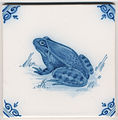Portal:Frogs
The Frogs PortalA frog is any member of a diverse and largely carnivorous group of short-bodied, tailless amphibians composing the order Anura (coming from the Ancient Greek ἀνούρα, literally 'without tail'). The oldest fossil "proto-frog" Triadobatrachus is known from the Early Triassic of Madagascar (250 million years ago), but molecular clock dating suggests their split from other amphibians may extend further back to the Permian, 265 million years ago. Frogs are widely distributed, ranging from the tropics to subarctic regions, but the greatest concentration of species diversity is in tropical rainforest. Frogs account for around 88% of extant amphibian species. They are also one of the five most diverse vertebrate orders. Warty frog species tend to be called toads, but the distinction between frogs and toads is informal, not from taxonomy or evolutionary history. An adult frog has a stout body, protruding eyes, anteriorly-attached tongue, limbs folded underneath, and no tail (the tail of tailed frogs is an extension of the male cloaca). Frogs have glandular skin, with secretions ranging from distasteful to toxic. Their skin varies in colour from well-camouflaged dappled brown, grey and green to vivid patterns of bright red or yellow and black to show toxicity and ward off predators. Adult frogs live in fresh water and on dry land; some species are adapted for living underground or in trees. Frogs typically lay their eggs in the water. The eggs hatch into aquatic larvae called tadpoles that have tails and internal gills. They have highly specialised rasping mouth parts suitable for herbivorous, omnivorous or planktivorous diets. The life cycle is completed when they metamorphose into adults. A few species deposit eggs on land or bypass the tadpole stage. Adult frogs generally have a carnivorous diet consisting of small invertebrates, but omnivorous species exist and a few feed on plant matter. Frog skin has a rich microbiome which is important to their health. Frogs are extremely efficient at converting what they eat into body mass. They are an important food source for predators and part of the food web dynamics of many of the world's ecosystems. The skin is semi-permeable, making them susceptible to dehydration, so they either live in moist places or have special adaptations to deal with dry habitats. Frogs produce a wide range of vocalisations, particularly in their breeding season, and exhibit many different kinds of complex behaviors to attract mates, to fend off predators and to generally survive. (Full article...) Selected article -The common toad, European toad, or in Anglophone parts of Europe, simply the toad (Bufo bufo, from Latin bufo "toad"), is a toad found throughout most of Europe (with the exception of Ireland, Iceland, parts of Scandinavia, and some Mediterranean islands), in the western part of North Asia, and in a small portion of Northwest Africa. It is one of a group of closely related animals that are descended from a common ancestral line of toads and which form a species complex. The toad is an inconspicuous animal as it usually lies hidden during the day. It becomes active at dusk and spends the night hunting for the invertebrates on which it feeds. It moves with a slow, ungainly walk or short jumps, and has greyish-brown skin covered with wart-like lumps. Although toads are usually solitary animals, in the breeding season, large numbers of toads converge on certain breeding ponds, where the males compete to mate with the females. Eggs are laid in gelatinous strings in the water and later hatch out into tadpoles. After several months of growth and development, these sprout limbs and undergo metamorphosis into tiny toads. The juveniles emerge from the water and remain largely terrestrial for the rest of their lives. (Full article...) Selected image
Need help?Do you have a question about Frogs that you can't find the answer to? Consider asking it at the Wikipedia reference desk. General imagesThe following are images from various frog-related articles on Wikipedia.
Did you know?
TopicsQuality ContentFeatured frog and toad-related articles - Australian green tree frog - Cane toad - Common toad - Frog - Green and golden bell frog
Good frog and toad-related articles - American bullfrog - Boiling frog - Ecnomiohyla rabborum - Poison dart frog Related portalsThings you can do
Associated WikimediaThe following Wikimedia Foundation sister projects provide more on this subject:
Discover Wikipedia using portals |
































































